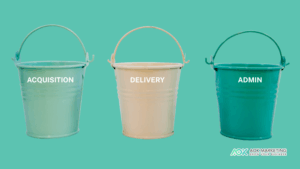If your marketing campaigns seem to succeed some months and fall flat in others, the problem may not be your funnel—it may be your calendar.
One question I hear regularly is this:
“How much does seasonality affect lead generation for my type of business?”
The short answer? Significantly. But the more important takeaway is that seasonality can be an asset—not a setback—if you know how to plan for it.
Why Seasonality Matters (Even If You Don’t Think It Does)
It’s easy to associate seasonality with obvious industries like retail or landscaping. But in reality, nearly every business is seasonal in some form. Some are shaped by weather patterns. Others by fiscal calendars, industry events, or buyer psychology.
What matters is not whether your business is seasonal—it’s whether you’ve recognized how seasonality affects your audience’s behavior, and whether you’ve adjusted your lead generation strategy accordingly.
Case Study: What Pool Companies and SaaS Providers Have in Common
Consider Home Painters Toronto. Their peak months are tied to warm weather, when exterior painting becomes viable. That’s expected.
But take a different industry—say, cybersecurity audits from PacketLabs or a CMS platform like Agility CMS. These companies experience lead surges during Q1 and Q3, in sync with budget planning and strategic review cycles. For them, the seasons are less about climate and more about cash flow and calendar planning.
Regardless of the industry, the common thread is that leads tend to arrive in cycles. Businesses that understand these rhythms can significantly outperform those that don’t.
Data-Driven Proof That Seasonality Affects Performance
Home Services: Precision Timing Cuts Costs
When Home Painters Toronto concentrated their campaigns during high-conversion months, they achieved conversion rates exceeding 10%, with costs per lead dropping to just $25—half the industry norm. This wasn’t a result of bigger ad budgets; it was a result of sharper timing.
B2B Services: Aligning with Budget Cycles
For PacketLabs, a provider of high-ticket cybersecurity audits, the sales cycle typically aligns with corporate budget planning periods. By intensifying paid search campaigns during Q1 and Q3, they saw stronger lead quality and higher close rates—more than justifying their $5,500 cost per acquisition.
Events and Conferences: Urgency as a Seasonal Trigger
When we worked with GS1 US to promote GS1 Connect 2023, the campaign’s most successful period came just before the event’s deadline. Registrations surged, ultimately exceeding 312% of the original goal. Timing wasn’t just a factor—it was the factor.
From Unpredictable to Strategic: The Opportunity Behind Seasonality
Rather than resisting these seasonal shifts, businesses can use them as strategic signals. When you know your lead gen cycles, you can:
-
Avoid spending during low-performance periods
-
Focus resources on high-conversion windows
-
Build steadier, more predictable revenue pipelines
The key lies in moving from reactive marketing to proactive planning.
A Practical Framework for Seasonal Lead Generation
To help you turn this insight into action, here’s a step-by-step framework for using seasonality to your advantage.
1. Audit Your Seasonal Trends
Review 12 to 24 months of lead and conversion data. Look for patterns tied to:
-
Time of year
-
Industry-specific events
-
Budget cycles
-
External factors like weather or holidays
Even if your seasonality isn’t immediately obvious, there’s usually a trend waiting to be uncovered.
2. Segment Campaigns by Season
Tailor your marketing campaigns to three distinct periods:
-
Peak Season: Increase spend and focus on conversions.
-
Off-Season: Shift to nurturing leads, growing your audience, and testing creatives.
-
Pre-Season: Use retargeting and urgency-based messaging to warm up your audience before demand spikes.
3. Adjust Budgets Strategically
Don’t distribute your ad budget evenly across the year. Concentrate spending where your audience is most likely to convert, and use quieter months for testing or lower-cost SEO content development.
4. Build Evergreen Lead Funnels
Invest in long-term assets that generate leads all year. Think SEO blog posts, downloadable guides, and evergreen webinars. These assets help maintain lead flow during slow seasons and reduce reliance on paid ads.
Case in point: Britannica. To offset drops in school-year traffic, they focused on evergreen educational keywords—ensuring stable performance regardless of academic breaks.
5. Map Campaigns to Buyer Intent
If your sales cycle takes 30, 60, or even 90 days, your marketing needs to start well before your peak season. Launch awareness and engagement campaigns ahead of high-conversion windows, so leads are already warmed up when it’s time to buy.
Summary: Know Your Season. Win Your Market.
Seasonality affects all businesses—it’s just a matter of when and how. Whether it’s a weather-dependent service like painting, a budget-driven B2B firm, or an event-based campaign, the most successful companies adapt to the seasonal dynamics of their market.
Here’s the formula:
-
Proof: Companies like Home Painters Toronto, PacketLabs, GS1 US, and Britannica all saw measurable improvements by aligning with their seasonal cycles.
-
Promise: When you understand your own seasonal trends, you can predict results, reduce waste, and improve ROI.
-
Plan:
-
Analyze past performance
-
Align campaigns with audience readiness
-
Budget intelligently
-
Leverage off-seasons for experimentation
-
Support it all with evergreen assets
-
Final Thoughts
Most marketers chase leads. The smart ones chase timing. By understanding your business’s unique seasonality, you can generate better leads, spend less, and grow faster.
About The Author
Dave Burnett
I help people make more money online.
Over the years I’ve had lots of fun working with thousands of brands and helping them distribute millions of promotional products and implement multinational rewards and incentive programs.
Now I’m helping great marketers turn their products and services into sustainable online businesses.
How can I help you?





